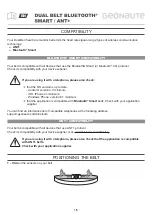
Additional information
12
48
En
Chapter 12
Additional information
Troubleshooting
Problem
Possible solution
• No power.
• The system cannot be switched on.
• Is the power cord disconnected? (See page 17.)
• Has
POWER
switch been turned on? (See page 19.)
• Check if you pressed buttons
0
to
9
or
on the remote control unit. (See page 19.)
• If the indicator on the system lights up red, press a number button,
0
to
9
, or
.
• The system cannot be operated.
• External influences such as lightning, static electricity, etc., may cause improper operation.
• In this case, operate the system after first turning off the power of the plasma display, or unplugging the power
cord and re-plugging it in after 1 or 2 minutes.
• Remote control unit does not operate.
• Are batteries inserted with polarity (+, –) aligned? (See page 18.)
• Are batteries worn out? Replace with new batteries. (See page 18.)
• Operate the remote control unit while pointing it toward the remote control sensor on the plasma display. (See
page 18.)
• Are you using it under strong or fluorescent lighting?
• Is a fluorescent light illuminated to remote control sensor?
• No image and audio is presented.
• Check if an external input has been unintentionally selected although you want to watch a TV channel. (See
page 20.)
• Check if you have selected a channel blocked with Child Lock. (See page 26.)
• Enter a password to temporarily cancel Child Lock. (See page 38.)
• Check the cable connection with the antenna. (See page 16.)
• Check the cable connection with the other equipment. (See pages 40 to 44.)
• No picture.
• Is connection to other components correct? (See pages 40 to 44.)
• Is a non-compatible PC signal being input? (See page 42.)
• Audio is output but no image is presented.
• Check if you have selected "Picture Off" for Energy Save. With this option selected, the screen is deactivated: only
sound is output. To restore the screen display, press any button other than
(
FRONT SURROUND
),
i
i
i
i
+/
i
i
i
i
–
or
e
e
e
e
(See page 34).
• Images are presented but no audio is
output.
• Check if you have selected the minimum volume. (See page 20.)
• Check that no headphones are connected.
• Check that the sound is not muted. (See page 20.)
• Check that the audio input is also connected. (See pages 40 to 42.)
• Check the sound system selected for a TV channel where problems have occurred (see page 21). Reselect the
correct sound system.
• Sound is output from only a single speaker.
• Has the balance been correctly adjusted? (See page 32.)
• Check that the speakers are connected properly (PDP-507XG only).
• Sound is reversed between the left and
right speakers (PDP-507XG only).
• The speakers are wired to the wrong speaker terminals.
• Picture is cut off.
• Is the image position correct? (See page 35.)
• Has the correct screen size been selected? (See page 36.)
• Strange color, light color, dark or color
misalignment.
• Adjust the picture tone. (See pages 28 to 31.)
• Is the room too bright? The picture may look dark in a room that is too bright.
• Check the color system setting. (See page 36.)
• After-image lag.
• After displaying a still image or a very bright image for a certain period of time, if the screen is then switched to a
darker scene, the previous image may appear as an after-image.
• This can be rectified by playing a rather bright moving image for several minutes. However, displaying a still image
for excessively long periods of time may cause permanent display deterioration.
• Brightness and color tone on both sides
differ from those in the center in 4:3 mode.
• If images in 4:3 mode or letterbox images are displayed for long periods or for shorter periods over several days,
an after-image may remain due to burning. This is a characteristic of plasma displays.
• We recommend that you enjoy watching images in a full screen mode as much as possible. (See page 36.)
• When watching images in 4:3 mode, we recommend you select “Auto” for the Side Mask setting. This adjusts the
brightness of the grey side masks according to the brightness of the main image. (See page 37.)
• Power is suddenly turned off.
• The system's internal temperature has increased. Remove any objects blocking vent or clean. (See page 15.)
• Check the power control setting. (See page 34.)
• Check the sleep timer setting. (See page 38.)
• Panel sounds /noises.
• Panel generated sounds—for example, fan motor noise, electrical circuit humming , glass panel buzzing—are
normal operation of a phosphor-based matrix display.
• When you change the Energy Save mode, you may notice a change in the panel sound. This is normal.
















































